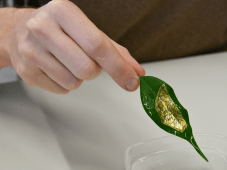Researchers from the Zurich Institute of Technology (ETH) are developing electronic components that are much thinner and more flexible than before. These components will be able to be wrapped even around a single hair without damaging their activity.
Dr. Moshe Nahamani

Researchers from the Zurich Institute of Technology (ETH) are developing electronic components that are much thinner and more flexible than before. These components will be able to be wrapped even around a single hair without damaging their activity. These components open completely new possibilities for the development of extremely thin and flexible sensors that can be placed even on the lens of the human eye.
Researcher Niko Münzenrieder dips a ficus leaf in water containing bits of glittering metallic membrane. With the help of tweezers, he moves one of these pieces and places it on top of the leaf. When he picks up this leaf, the thin layer sticks to it as if it had been glued into it. In doing so, the researcher demonstrates the special properties of this electronic component which has the form of an extremely thin membrane. "These extremely thin and new transistors adhere to a wide variety of types of surfaces and do so perfectly," explains the physicist.
In the laboratory of Professor Gerhard Tröster, scientists have been studying flexible electronic components, for example transistors and sensors, for some time. The goal is to weave these types of components into fabrics and attach them even to the skin in order to make various objects "smart", or to develop convenient and inconspicuous sensors that can monitor various functions inside and on the human body. The researchers managed to achieve significant progress towards this goal and their work has long been published in the prestigious journal Nature Communications. Using this new type of thin-layer technology, the researchers were able to produce extremely flexible and functional electronic components.
Within a year, the researchers were able to develop a method for the production of components consisting of these thin layers. The membrane consists of the parylene polymer that the researchers vaporize, layer by layer, into a regular 5 cm slice. The perylene layer has a maximum thickness of 0.001 mm, so it is 50 times thinner than a human hair. In subsequent steps, the researchers used standard methods to build transistors and sensors from semiconducting materials, such as indium-gallium-zinc oxide, and conductive materials, such as gold. In the final step, the researchers release the perylene layer from the wafer along with the electronic components attached to it.
An electronic component produced by this method is extremely flexible and adaptable, and - depending on the material used to make the transistors - can also be transparent. The researchers verified the theoretically calculated bending radii at a rate of 50 microns during experiments in which the electronic membrane was placed on top of a human hair and wrapped it perfectly. The transistors, which are less flexible than the substrate due to the ceramic materials used to build them, still functioned perfectly despite the considerable bending.
The researchers note that contact lenses could be a potential field for the application of these flexible electronic components. In the advanced stages of the research, the scientists connected the transistors made up of the thin layer, along with strain gauges, to regular contact lenses. They placed the lenses on top of an artificial eye and thus they were able to test whether the membrane, and especially whether the electronic components included in it, can withstand the bending radii of the eye and still function properly. The tests showed that in fact this type of "smart" contact lenses could be used to measure intraocular pressure - a major risk factor in the development of glaucoma.
At the same time, the researchers still have to overcome several technical hurdles before a commercially available solution can be thought of. For example, the way in which the electronic components are connected to the contact lenses must be further optimized in order to take into account the effects that will have on the aqueous environment of the eye. In addition, the operation of sensors and transistors requires the supply of energy, although in a small amount, energy that currently must come from an external source. "In the laboratory, the thin layer can be easily connected to an energy source under a microscope. Contrary to that, it will be necessary to find another solution to connect the units to the real eye," explains the lead researcher.
The lead scientist of the study, Professor Tröster, has already attracted attention in the past when he published a number of unusual ideas regarding wearable electronic components. For example, the researchers were able to develop fabrics into which electronic components were woven; In addition, they were able to use sensors to monitor the body functions of a skier during his sporting activity.

3 תגובות
This is a step towards connecting electronic devices to living cells...
Such a connection would be a huge breakthrough in many, many areas of science.
Why think negatively?
You can think positively:
1) A light and flexible pacemaker.
2) Flexible computer screen.
3) Delicate and flexible catheterization and surgical instruments. (laparoscope).
Only I'm thinking about a GPS that will be attached to a citizen and he didn't even know about it